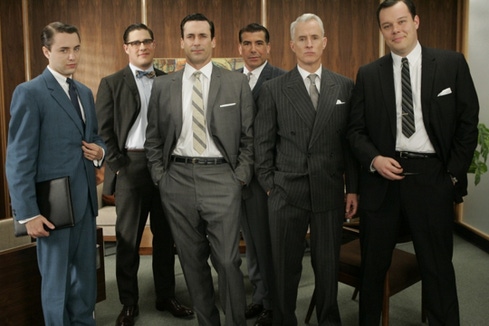Why do you need a sweater in the office in the summer? Because we're cooling it based on a formula that dates back to when the Beatles were still together.

Every office has at least a few people who huddle under a sweater in the middle of summer. I'll wager most of those people are women. Not because I think women are weak and men are strong. But because of a sexist assumption made more than 50 years ago. According to a paper appearing in Nature, we've built office climate controls to favor the metabolism of men.
We've set "room temperature" in our minds as 72 degrees Fahrenheit, because a study done in the 1960s showed the average office worker was a 40-year-old man weighing 154 lbs. In other words, we've been cooling our offices like an episode of Mad Men.
Notice something about that picture? Well, for one, men wore suits and ties in the office. They were a tad warmer than business casual today. In real life, working women of the era probably did not wear the miniskirts and low-cut shirts we see on TV. Instead, they wore business attire that had more layers and was made of heavier materials than we're accustomed to today.
Besides that, the average weight in America for men these days isn't 154 lbs but 195 lbs. In other words, we're older, heavier, and most importantly, we actually let women work in an office (gasp!). Why are we still cooling a building based on this formula?
Turns out, because of their metabolism and general size, women prefer rooms at 78 degrees. Men, even if you account for various changes in body types, like it much cooler. By ignoring the needs and desires of women, we are making quite a few mistakes.
For one, we're making half our workforce unhappy because of norms created in a more sexist time.
We're also wasting a lot of energy, and hurting our environment.
It gets much worse in data centers. The average data center temperature is set between 68 and 72 degrees, even colder than the office. I'm only partially joking when I wonder if this is the real reason there are so few women in IT. Despite calls from Sun, Google, and others to allow the data center to get warmer, for the most part we're still chilling our data centers like Santa's workshop.
But the average data center can save 4% on energy costs for every degree of temperature increase. The dollar value of energy savings for offices would be a little lower, depending on size, but the savings would still be very real.
While office temperature has never been a major skirmish in the battle of the sexes, it might be time to call a thermostat truce and meet somewhere in the middle. Raising the thermostat in the office would make half your staff more comfortable without hurting the other half, save your company money, and help the environment. It is time to rethink room temperature for the post-Mad Men generation.
If lowering the thermostat isn't an option, here are some other things to consider. For reasons no one understands, married women don't mind the cold as much. Shorter people also do better because their blood doesn't travel as far to the extremities. Red heads, for some reason, handle discomfort and pain better. So if you can't handle the thermostat change, I suggest hiring only short, married women with red hair. How's that for a Man Men-style solution?
What do you think? Do you tend to be cold in the office? Could everyone stand having the thermostat raised a few degrees during the dog days of summer? Tell me in the comments section below.
About the Author(s)
You May Also Like







